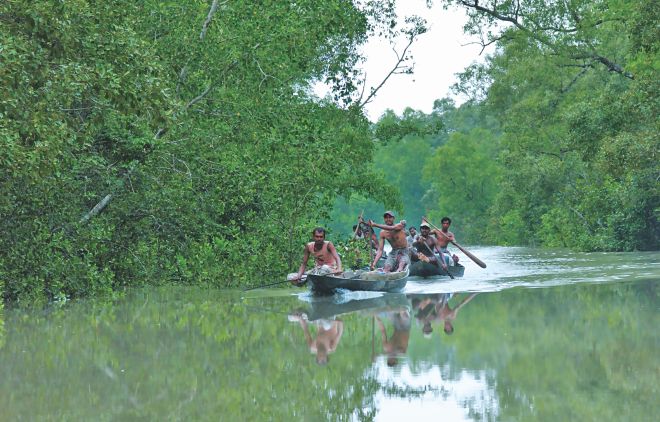
SUNDARBANS, the largest mangrove forest in the world, is a living and most effective natural fence protecting the coastal belt areas. It indeed saved us from the devastation of cyclones Sidr and Aila in the recent past. Not only so, it is the forest that offers various sources of livelihood to more than five hundred thousand local inhabitants.
Unfortunately, the Sundarbans is now in danger because the government is moving ahead to install a coal-based thermal power plant at Rampal with the capacity of producing 1,320 MW of electricity. The plant will be located only 9 km away from the Sundarbans, and will cover 1,834 acres of land. The government has been justifying the location of the project on the ground that it is at a ‘safe’ distance from the mangrove forest.
The proposed plant will require 13,000 tons of coal. This huge amount of coal will be transported through the Possur river that runs deep into the Sundarbans and flows around its adjacent areas. It is well known that the large ships carrying coal, the turbines, the compressors, the pumps, the generators and the cooling towers of the power plant will create a lot of sound, which will inevitably have a fatal effect on the biodiversity of the forest. Moreover, the river will be helplessly exposed to coal wastes. This description is not enough to perceive the potential devastation the Possur river is more likely to be confronting soon, given the fact that the operation of the power plant will not be short-term.
More dangerously, the power plant will require withdrawal of 9,150 cubic meter of water per hour from the Possur river for its functioning. The extraction of such massive volume of water will undoubtedly mess up the natural organisms of the river systems of Sibsha and Possur that provide the lifeline to the Sundarbans. In addition to this, the proposed plant will have a coal stockyard and a dust disposal pond along the boundary of the Possur river.
It is difficult to imagine what will happen to the river when a ‘mountain’ of more than seven hundred thousand tons of fly-ash and two hundred thousand tons of bottom ash are released as soon as the plant starts functioning. These contain hazardous and toxic chemicals such as arsenic, mercury, lead, nickel, and radium. There will also be regular emission of some 142 tons of sulfur dioxide and 85 tons of nitrogen dioxide. So many toxic substances are enough to slowly eat up the world’s largest mangrove forest.
The very first victim of this proposed power plant would be the Possur river, a major source of water in the Sundarbans. Any damage to any network of the rivers or any water channel that flows in and around this forest means eventual death for it. It is neither realistic nor scientific to think of the Sundarbans in isolation of its river network and the overall eco-systems. It is, thus, futile to rationalise the location of the proposed power plant in terms of its distance from the Sundarbans! Whatever the distance of the project is, if any part of the eco-system gets damaged, the Sundarbans will anyhow get endangered.
It is also important to note that the Possur river and its adjacent confluence of Maidara and Chinkura rivers are home for at least 120 types of fishes that include hilsha, parshe, bhetki, taposhi, and even tulardandi. The slightest harm to the river will not only push those indigenous fish species into extinction, but will also destroy the livelihood of the fishermen belonging to the low income group. Not to mention the extinction of the Iraboti dolphins.
Moreover, the massive land acquisition programme of the government for undertaking this Rampal project has already displaced the local poor people from their own residences. As many as 4,000 families have been compelled to migrate to other places.
As far as the commercial prospects of the plant are concerned, it is important to understand the market vulnerability and volatility involving the import price of the coal. The availability of ‘high quality’ coal depends on international price, and the transportation costs will be very high. The availability of coal in the international market is not also predictable. Thus, it is most likely that the electricity to be produced in this plant will end up being highly expensive.
Against such a grim commercial prospect, the Indian company NTPC has been successful in ensuring a major share of the profit pie. Its total direct investment is not more than 15%, while it will enjoy 50% ownership over the power plant. More oddly, Bangladesh will have to bear the brunt of environmental and social disasters. However, these catastrophes will go beyond Bangladesh territory and cause destruction to the part of the Sundarbans falling in India.
Interestingly, the Indian government does not allow construction of such plants in its own territory. Their recently enacted ‘EIA guidelines for thermal power plant 2010’ forbids this kind of development activity within 25 km of the officially declared forest boundaries. The Indian government is unfortunately violating its own law at Rampal taking advantage of the loopholes that exist in Bangladesh forest laws.
There are some Bangladesh policy makers who claim that the employment of some ‘super critical technology’ in the Rampal power plant will reduce the environmental pollution. However, there is an argument that this ‘super critical technology’ can reduce pollution at best by 10%. Under the circumstances, one might ask if ‘super critical technology’ is so efficient in tackling environmental degradation, why is India not exploiting this technology in its own land to produce electricity within the permitted distance from forest boundaries?
The government of Bangladesh flouted the basic rules while taking over local land for the proposed plant. They did so well before taking site clearance certificate from the Department of Environment of Bangladesh. Similarly, the EIA report has been released only after they have done all the needful at Rampal in the last 2/3 years. The EIA report prepared by the CEGIS for its client Bangladesh Power Development Board is ambiguous, whimsical, and unjustifiably optimistic. During the public hearing on the project the participants called for cancellation of the report, but that went unnoticed.
There are also people who argue that the plant would generate massive employment and help save the Sundarbans from encroachment as the proposed project would reduce livelihood pressure of the local people. The truth is, the Forest Department along with some environmental and conservation NGOS, since 2009, have been implementing or have already implemented at least ten foreign donors’ funded projects, including the Integrated Protected Area Co-Management (2010-2013), and Sundarbans Environmental and Livelihood Security (2010-2014).
The major objective of all these projects is to generate sources of alternative livelihood for the forest-dependent poor people. Thus, the question is, why do we still need to have a power plant to save the Sundarbans from the ‘clutches’ of the poor despite the presence of those projects? The claim that the poor communities living in the forest area grab land for their livelihood does not have any merit.
The irony is, those who have been resisting the environmentally degrading power plant are being dubbed either as ‘anti-development’ or as ‘utopians.’ This is in fact not a new phenomenon. A common perception is that this group of people does not have any clue about any alternative, nor has any idea of how to economically advance the country. To these so-called ‘messiahs’ of development, the effort to save nature is only a luxury that Bangladesh cannot afford at this moment. Their preferred strategy of development is to “pollute first, and clean up later.” But while advocating such strategy, they forget that the philosophy of modern development has undergone a fundamental shift in the last few decades.
Tracking the global ruins of ‘modernisation’ and traditional ‘development,’ the new generation of development scholars argues that the environment and development are inseparable; their interconnection is no longer a mere fantasy. They understand development as an integrative term. To them, development ignoring social and environmental concerns is indeed an emblem of narrow and visionless thoughts.
We do not require rocket science to understand the potential risks of developing Dhaka city compromising with the long term necessity of conserving the Buriganga river and the other important water bodies. Why are we sacrificing those precious gifts of nature for urban ‘development’? Dhaka is now the second most uninhabitable city on earth!
There are many alternatives ways of energy production, but the Sundarbans is unique. It is neither a village nor a residential area. It is a government-declared ecologically critical area, World Heritage site, as well as a Ramsar site that requires extra caution and protection. This is also not a property that belongs only to Bangladesh; it is a natural asset of the whole of mankind. We expect that good sense of official policy makers of both Bangladesh and India will prevail and they will take all the needful measures to cancel the Rampal power plant to save the Sundarbans, the living defender, to protect Bangladesh from cyclones and other disasters.
The writers: Akmal Hussain, Asad Ullah Khan, Gitiara Nasreen, Nasim Akter Hossen, Abdullah Harun Chowdhury, Bina De Costa, Zobaida Nasreen, Sadaf Noor E Islam, Omar Tarek Chowdhury, Mahmudul Sumon, Samina Lutfa Nitra, Maha Mirza, Fahmidul Haq, Moshahida Sultana, Mawdud Rahman, Mohammad Tanzimuddin Khan
The writers are teachers of universities in Bangladesh, Australia, environmental scientist, engineer, and development activist.
Published in the Daily Star on 28 September 2013 (available at http://www.thedailystar.net/news/bangladesh-cannot-survive-without-the-sundarbans)





